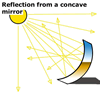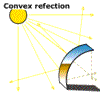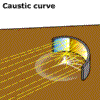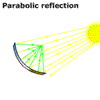 When light is reflected from any mirror the same rules of reflection
apply. For a plane mirror the angle at which the light ray strikes the
surface (the angle of incidence) is equal to the angle at which the same
light ray leaves the surface (the angle of reflection).
When light is reflected from any mirror the same rules of reflection
apply. For a plane mirror the angle at which the light ray strikes the
surface (the angle of incidence) is equal to the angle at which the same
light ray leaves the surface (the angle of reflection).
For mirrors with curved surfaces this law of reflection still applies, but the curved surface of the mirror creates different images to that of a plane mirror.
Convex and concave mirrors
Curved mirrors have a variety of forms, two most common types are convex
and concave. A convex mirror has a surface that bows outwards and a concave
mirror has a surface that caves inwards. Each has distinctive characteristics
in terms of size of image and whether the image is real or virtual.
Try this with a highly polished spoon, or a pair of reflective Sun glasses. Start with the spoon at arms length and observe your image, then move the spoon closer and closer, watch what happens to the image.
Caustic curvesThis curved shape image is produced because the rays of light reflecting from the surface do not meet at a single point of focus but are spread over a focal plane. To focus light from a wide beam source an adaptation of the concave mirror is needed.
Parabolic mirrorsFunny mirrors
At an amusement park you might find mirrors made like a combination of
concave and convex mirrors. These can produce very funny results as the
image of the body is distorted!
Round convex mirrors are useful as security aids in shops where a broad (though distorted) image of an otherwise hidden aisle is clearly shown. They are also valuable to show traffic at a blind junction. Wing mirrors on late model cars sometimes are convex, with an appropriate warning that the image is deceiving.
| Copyright owned by the State of Victoria (Department of Education and Early Childhood Development). Used with Permission. |
|
|||||||||||||||||||||||||||||||||||||||||||||||||||||||||||||||||||||||||||||||||||||



